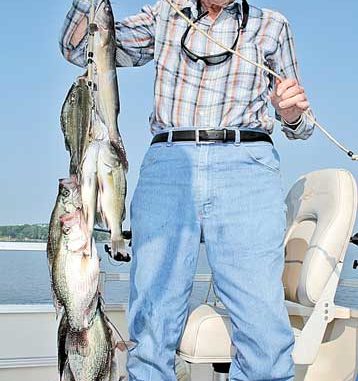
Generally, some the biggest fishing news on the Santee Cooper lakes in January is the cold-weather fishing for blue catfish — but that’s certainly not the only fishing game on the lakes.
When the water temperature dips, as is typical of January and early February, the striper surface schooling activity slows considerably, but catching stripers doesn’t have to stop. Long-time guide Don Drose of Manning said that trolling during the dead of the winter can be very effective for taking big stripers.
“Stripers follow the forage, and during the winter, a lot of time the forage will get into the creeks and larger coves,” Drose said. “The fish will usually orient to the drops along the creek channels. Some of the better places on Lake Marion include Wyboo, Potato and Taw Caw creeks. However, there are numerous places on both lakes where trolling is effective.”
Drose said deep-diving crankbaits that dig down to depths of 12 to 16 feet are ideal. Troll along the ledges and drops, focusing on areas where lots of shad are concentrated.
Aside from striper fishing, the waterfowl hunting opportunities are excellent this month. In fact, it among the favorite wintertime pursuits of many outdoorsman around the Santee Cooper area. While the seasons have staggered dates, January provides great opportunities for extended waterfowl hunting. The S.C. Department of Natural Resources’ website (www.dnr.sc.gov) has waterfowl seasons and regulations, as does the Waterfowl Rules and Regulations brochures that are available.
An often-overlooked wintertime opportunity on Lake Marion and Lake Moultrie is fishing for white perch. These fish are also known for their potential for overpopulation, and based on information from the SCDNR, high populations of white perch may have negative impacts on other fisheries.
That’s a primary reason why they have been de-listed from the protective status of gamefish species. Because white perch are no longer protected as a gamefish, there are no limits on the taking of this fish. According to the SCDNR, the bill removing white perch from the gamefish list was developed due to concerns raised during the Striped Bass Stakeholders Working Group, which was convened to identify ways to restore the striped bass fishery in the Santee Cooper system.
A lot of effort is being put into restoration of the striped bass fishery in the Santee Cooper lakes. A lot of local anglers certainly blame the white perch for the disappearance of the white bass fishery in Santee Cooper as well.
According to the SCDNR, the white perch is native to coastal areas from Nova Scotia to South Carolina, but it has been historically an estuarine species. Now, white perch have spread extensively. According to a SCDNR news release, this expansion is a due both to movement through fish-migration structures and relocation by fishermen.
White perch have always shared feeding and habitat requirements with both striped and white bass, according to the SCDNR. However, adult white perch were not historically found in the same location as juvenile striped bass, so the two did not compete for food. The expansion in the range of white perch and the increase in abundance of this fish in our rivers and reservoirs may be impacting striped bass populations through competition. A decline has also been noticed in white bass populations where white perch populations are increasing too, according to the SCDNR.
Broken Lines and Tangled Dipnets
The bad news about white perch has been noted above, but perhaps oversimplified. However, an upside does exist. During January, white perch will pile up in huge numbers in small areas, making them ripe for easy picking if you fish for them properly. While some are small and stunted, there are plenty of perch that reach fillet size.
A great technique for catching perch is dragging minnows on tightlines along ledges, humps and drops in both lakes. Crappie and catfish also stack up at this time of the year in these same places and provide the opportunity to catch a true smorgasbord of fish species. Not only is this a great technique for fast-paced fishing action in cold weather, anglers can load up on great eating fish. Do the lakes and yourself a favor and eat more white perch, along with crappie and catfish, this winter.




Be the first to comment